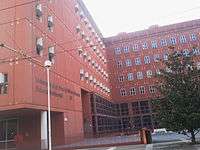Zone 9 of Milan
| Zona 9 di Milano Municipality 9 | |
|---|---|
| Zona of Milan | |
 Location of Zone 9 of Milan | |
| Country |
|
| Region | Lombardy |
| Province | Metro City of Milan |
| Comune | Milan |
| Created | 5 March 1999 |
| Government | |
| • Type | Municipal Council |
| • President |
Giuseppe Antonio Lardieri (2016-2021) |
| Area | |
| • Total | 8.15 sq mi (21.12 km2) |
| Population (2013) | |
| • Total | 181,598 |
| • Density | 22,270/sq mi (8,598/km2) |
| Time zone | CET (UTC+1) |
| • Summer (DST) | CEST (UTC+2) |
| Website | Municipality 9 |
The Zone 9 of Milan (in Italian: Zona 9 di Milano) is one of the 9 administrative zones of Milan, Italy.[1] It corresponds to the northern area of the city.
It was created on 5 March 1999 by the union of the previous Zones 2 (Centro Direzionale, Greco, Zara), 7 (Bovisa, Dergano), 8 (Affori, Bruzzano, Comasina) and 9 (Niguarda, Bicocca). On 14 April 2016, in order to promote a reform on the municipal administrative decentralization, the City Council of Milan established the new Municipality 9, a new administrative body responsible for running most local services, such as schools, social services, waste collection, roads, parks, libraries and local commerce.[2]
Subdivision
The borough includes the following quarters:
- Affori, a rural settlement referenced as early as 915 which was annexed to Milan in 1923;
- Bicocca, a district incorporated in the city in 1841. In the 19th century, the area of Bicocca was affected by a quick industrialization process, and was gradually absorbed into the urban agglomerate of Milan. In the first half of the 20th century Bicocca became the centre of an important industrial area that also comprised Greco and Sesto San Giovanni, and that greatly contributed to the Italian economy of the time. The first facilities to be established in Bicocca were those of Pirelli, Ansaldobreda, and Wagons-Lits. In the nearby area of Sesto, the Falck steel mill was also a prominent factory. Pirelli maintained a leading role in the area. A historic neighbourhood of Bicocca, "Borgo Pirelli" ("Pirelli Town"), was originally developed as a residential area for the thousands of workers that were employed in the Pirelli factories. Deindustrialization of the Bicocca district began in the 1970s. In 1985, Pirelli started a project to redevelop the area. The resulting "Progetto Bicocca" (Bicocca Project), which affected an area of 960.000 m2, was the largest urban transformation project in the history of Italy, and the second in Europe, after that of Berlin. The prominent results of this project were the construction of a large university district (called University of Milan Bicocca) and of the Teatro degli Arcimboldi, a large theatre that has also been used to house La Scala shows while the historic La Scala theatre was undergoing restoration. Other main buildings realized by the project were a seat of the CNR (National Council of Research) and the Istituto Neurologico Besta, a major neurological hospital. Several companies now have their Milanese headquarters in Bicocca, including Pirelli, Siemens, Deutsche Bank, Reuters, Fastweb, Johnson & Johnson, and Hachette-Rusconi;
- Bovisa, An industrial area in the outskirt of the city since the second half of the nineteenth century, Bovisa has undergone a thorough transformation since the 1950s, when most factories were dismantled to be moved farther from the expanding city center. After a period of decay, a process of renewal followed, which transformed the Bovisa into a mainly residential suburb. The district is now experiencing an upturn, thanks to the many activities which relocated in the zone. Among them, the Politecnico di Milano, with its Bovisa campus, played a major role.[3] The campus features the schools of Design, Architecture and Industrial Engineering. The area has since gained notoriety as a design and art "melting pot". This trend was confirmed in 2006, when a new headquarters of the Triennale design and art museum, dedicated to modern art, was established in this area;
- Bovisasca, a former industrial district, now transformed into a mostly residential area;
- Bruzzano;
- Centro Direzionale, originally designed to accommodate office buildings for tertiary activities. A relevant part of the design effort focused on the realization of adequate infrastructures supporting heavy daily commute, although only some of the corresponding projects were actually implemented. The main transportation hub in the area is Porta Garibaldi railway station, with connection to the Milan Metro, the suburban network and national rail lines;
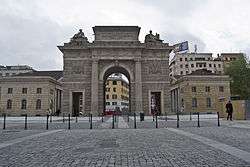
- Comasina;
- Dergano;
- Fulvio Testi;
- Isola; a district (quartier) of Milan, Italy. It is an area located within Zone 9 of the city.
- La Fontana;
- Montalbino;
- Niguarda;
- Porta Garibaldi;
- Porta Nuova;
- Prato Centenaro;
- Segnano.
Historical development
Apart from Affori, Bruzzano, Comasina, Dergano and Segnano, which were autonomous municipalities before beign annexed to the main city of Milan in 1923, the urban development of the Zone 9 has always been linked with the development of the Centro Direzionale district.
Overall, the realization of the new district took place between 1955 and 1962, but was later suspended as a consequence of the lack of an actual regulation preventing tertiary activities to be established in the city centre. For several years thereafter, the Centro Direzionale remained an heterogeneous and sparse area. Some skyscrapers were built (including the Pirelli Tower, the Galfa Tower, and the Servizi Tecnici Comunali Tower) but other areas remained undeveloped and fell in decay. A major example of the inconsistent use of urban areas in the district was the establishment of the Varesine "Luna Park" (now dismissed) amidst a supposedly office and financial district.


Porta Nuova district development
After a long period of urban decay, the Porta Nuova district is now undergoing a massive renewal, thanks to the "Progetto Porta Nuova" (Porta Nuova Project).[4] The project, which has been under construction since the late 2000s, includes several modern high rise buildings, cultural centres, and a large city park. As a result of these developments, the Porta Nuova district will ideally merge with the bordering Centro Direzionale di Milano, the oldest business district of Milan that is characterized by 1950s-1960s towers, many of which dedicated to government offices and other major public and private companies.
This project effects areas from the neighborhoods of Isola, Varesine and Porta Garibaldi. Construction started in 2009, with completion planned in 2014.[5] The project involves the work of noted architects such as Cesar Pelli, Stefano Boeri and Nicholas Grimshaw. The redevelopment area extends from Porta Garibaldi station to piazza della Repubblica and from Porta Nuova gate to Palazzo Lombardia.
Bosco Verticale
The project was designed as part of the rehabilitation of the historic district of Milan between Via De Castillia and Confalonieri. It consists of two residential towers of which the largest is 26 floors and 110 meters high (called Torre E) and the smaller tower is 18 floors and 76 meters high[6] (called Torre D). It contains 400 condominium units[7] priced from 3,000 Euro per square metre and higher.[8]
It is called Bosco Verticale because each tower houses trees between three and six meters which help mitigate smog and produce oxygen. It is also used to moderate temperatures in the building in the winter and summer.[9] The plants also attenuate noise.[10] The design was tested in a wind tunnel to ensure the trees would not topple from gusts of wind.[11] Botanists and horticulturalists were consulted by the engineering team to ensure that the structure could bear the load imposed by the plants.[12][13] The steel-reinforced concrete balconies are designed to be 28 cm thick, with 1.30 metre parapets.[14]
Towers and skyscrapers
| Name | Image | Construction started | Completion | Height
(including spire) |
Current status |
|---|---|---|---|---|---|
| Unicredit Tower |  |
|
|
(230m) |
Completed |
| Palazzo Lombardia | |
|
|
Completed | |
| Torre Solaria | |
|
|
Completed | |
| Torre Diamante | |
|
Completed | ||
| Pirelli Tower |  |
|
|
Completed |
Municipal government
Since 2016 the president of the borough is directly elected by citizens. The borough council is elected every five years, with a system under which voters express a direct choice for the president or an indirect choice voting for the party of the candidate's coalition. If no candidate receives at least 40% of votes, the top two candidates go to a second round after two weeks. This gives a result whereby the winning candidate may be able to claim majority support.
Last election occurred on 5 June 2016:
| Candidate | Party | Votes | % | |
|---|---|---|---|---|
| Giuseppe Antonio Lardieri | FI | 27,637 | 40.91 | |
| Stefano Indovino | PD | 26,295 | 38.92 | |
| Claudio Sasso | M5S | 8,731 | 12.92 | |
| Andrea Quattrociocchi | MC | 2,582 | 3.82 | |
| Michele Carulli | RI | 1,313 | 1.94 | |
| Giacinto Vito Carriero | 1,007 | 1.49 | ||
| Total | 67,565 | 100.00 | ||
Table below shows the current composition of the borough council:
| Term | Majority | Opposition | Total | President |
|---|---|---|---|---|
| 2016 - 2021 | 8 FI 7 LN 2 NCD 1 FdI |
7 PD 3 M5S 1 SI 1 NM |
31 | Giuseppe Antonio Lardieri (FI) |
Education
In this borough are located 17 primary schools, while there are two important universities:
- University of Milano-Bicocca, which has its origins from the splitting of the University of Milan, which with about 90,000 students in the 1990s was becoming overcrowded. Bicocca district was chosen as the location for the new university. This area was occupied by the Pirelli industrial complex until the 1980s and the new campus was part of a larger urban renewal project. The university was officially established on 10 June 1998.
- Polytechnic University of Milan-Bovisa campus, located in the Bovisa district and became active in 1989; campus Bovisa is today composed of campus Durando, opened in 1994, and campus La Masa, inaugurated in 1997. The first is the seat of the School of Design, while the second is dedicated to Industrial, Mechanical, Aerospace, and Energy Engineering faculties. Bovisa also houses the related research facilities, including the wind tunnel.
Parks and gardens
In this borough there are many public parks and gardens:
- Northern Park of Milan (3,200,000 sq), opened in 1975
- Bruzzano's wood (120,700 sq), opened in 1968
- Nicolò Savarino park (31,590 sq), opened in 1990
- Villa Litta park (76,400 sq), realized in 1687, opened as public park in 1927
- The Cherry Hill (30,000 sq), opened in 2007
- Wanda Osiris garden (22,100 sq), opened in 1991
- Giacomo Della Porta garden (4,400 sq), opened in 1999
- Porro and Jenner garden (1,500 sq), opened in 2000
A great park of 90,000 sq is expected to be realized by 2017 inside the new Porta Nuova district. On this area, on the occasion of Expo 2015, was temporally created the big Agnes Denes' Wheatfield.
Transport
Stations of Milan Metro in the Zone 9:
 Gioia, Garibaldi FS;
Gioia, Garibaldi FS; Affori Centro, Affori FN, Comasina, Dergano, Maciachini, Zara;
Affori Centro, Affori FN, Comasina, Dergano, Maciachini, Zara; Bicocca, Bignami, Ca' Granda, Garibaldi FS, Isola, Istria, Marche, Ponale, Zara.
Bicocca, Bignami, Ca' Granda, Garibaldi FS, Isola, Istria, Marche, Ponale, Zara.
Suburban railway stations in the Zone 9:
Notable places
- Milano Porta Garibaldi railway station
- Niguarda Hospital
- Triennale
- Corso Como shopping district
- Teatro degli Arcimboldi
- Gae Aulenti square
- Bosco Verticale
- Palazzo Lombardia, seat of the Regional Government of Lombardy
- Porta Nuova business district
- Northern Park of Milan
- Bruzzano Wood
- Porta Nuova Wheatfield
Gallery
 Centro Direzionale during the 1960s
Centro Direzionale during the 1960s Via Pirelli
Via Pirelli Industrial buildings in Bovisa district
Industrial buildings in Bovisa district- Gae Aulenti square
 Palazzo Lombardia, seat of the Regional Government of Lombardy
Palazzo Lombardia, seat of the Regional Government of Lombardy.jpg)
.jpg) New buildings in Isola district
New buildings in Isola district- AXA Palace
 Unicredit Tower is the tallest building of Italy
Unicredit Tower is the tallest building of Italy The Ziggurat under construction, seat of Google Italia
The Ziggurat under construction, seat of Google Italia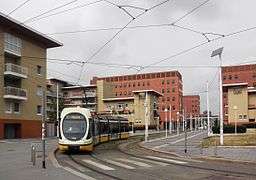 University of Milano-Bicocca campus
University of Milano-Bicocca campus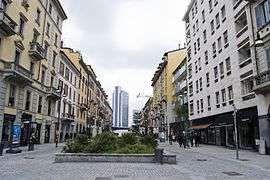 Corso Como shopping district
Corso Como shopping district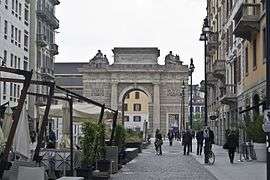 Corso Como and Porta Garibaldi
Corso Como and Porta Garibaldi- Main entrance of Niguarda Hospital, opened in 1939

 Porro and Jenner garden with the XV century Boscaiola Farmhouse
Porro and Jenner garden with the XV century Boscaiola Farmhouse
Maps
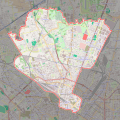 Map of Zone 9 of Milan
Map of Zone 9 of Milan
References
- ↑ (Italian) The 9 city councils of Milan (municipal website)
- ↑ Municipality of Milan - Municipalities
- ↑ Politecnico di Milano: Milano Bovisa
- ↑ "Milano Porta Nuova official website". Retrieved 29 October 2012.
- ↑ "Il progetto Porta Nuova avanza". Retrieved 2010-01-26.
- ↑ stefanoboeri
- ↑ Stella: June June 2009
- ↑ Stella: June 2009
- ↑ Rozza: October 2012
- ↑ DNews: 2011
- ↑ Stella: June 2009
- ↑ Woodward: October 2011
- ↑ Stella: June 2009
- ↑ Peri: December 2011
External links
| Wikivoyage has a travel guide for North Milan. |
![]() Media related to Zones of Milan at Wikimedia Commons
Media related to Zones of Milan at Wikimedia Commons
- (Italian) Zone 9 of Milan (municipal website)
Coordinates: 45°31′01″N 9°11′31″E / 45.516888°N 9.191866°E

